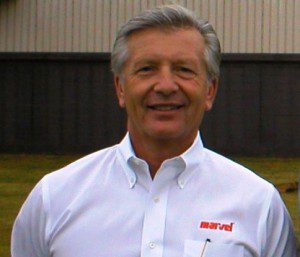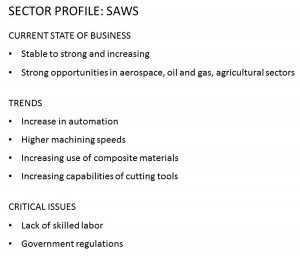2012 State of the Industry: Saws
Forecast: Increasing automation and higher machining speeds on composite materials is creating strong opportunities in the aerospace, oil and gas, agricultural sectors for saw manufacturers.
Posted: January 10, 2012
Forecast: Increasing automation and higher machining speeds on composite materials is creating strong opportunities in the aerospace, oil and gas, agricultural sectors for saw manufacturers.
 Doug Harris
Doug Harris
President and CEO, HE&M Saw, Inc.
Manufacturer of vertical, horizontal, plate and double column production band saws, multi-guide arms saws, computer controlled saws, bar feed systems, material handling tables and other equipment for the metalworking industry.
CURRENT STATE OF BUSINESS
There are three industry sectors that show a good prognosis for a robust business environment: oil and natural gas, aerospace, and agriculture. If you are serving these markets, your long-term outlook is promising.
MAJOR TRENDS
First, the oil and natural gas sector. With the large finds in Western Canada, the Dakotas, Wyoming, Texas, and Pennsylvania, the experts indicate that if the U.S. didn’t import another drop of foreign oil, there is enough to satisfy U.S. needs for approximately 70 years using horizontal drilling and fracking. This is based on current usage and estimates for future demand. This does not account for the availability of natural gas. There are between 150 and 300 years of supply available at existing demand.
The problem we face in both oil and natural gas is infrastructure. We currently do not have an efficient, cost-effective method to transport the oil from the wells to the refineries; 70 percent to 80 percent of which are currently located in the Gulf Region. The U.S. hasn’t built a new refinery in over 30 years. There are also no pipelines to connect the new finds to existing refineries.
There is a viable proposal to increase the infrastructure, the Keystone Pipeline, that would not only solve the transportation problems of bringing the oil from the new finds in the Dakotas, Wyoming, Montana, and Western Canada to the refineries in the Gulf, but would also influence labor problems in the U.S., creating 20,000 jobs. This pipeline would run from Western Canada through Montana, South Dakota, Nebraska, Kansas and Oklahoma to the refineries in Texas. The need for refineries and pipelines creates a large demand for steel. The tools needed to drill wells require large forgings, downhole pipes, and couplers, again creating a demand for steel, making steel an excellent growth opportunity. All of this steel needs to be produced, formed and cut.
The face of the aviation industry has changed due to the high cost of fuel. The demand for oil on the open market has increased due to the expanding needs of developing countries such as India, Africa and China. This demand has driven up the price of oil. The single largest cost for the airline industry is the cost of fuel. The increase in the price of oil is forcing the airlines to upgrade their fleet of planes. The newer engines are more fuel-efficient.
In order to be competitive, they need more modern fleets of planes, hence the large orders that are being given to Airbus and Boeing. The exotic materials for the engines and the aluminum for the air frames are in high demand. In order to meet the demand for more fuel efficient planes, the aircraft industry is looking at doubling production over the next ten years. This is also a growth opportunity for those manufacturers that cut, machine and form these types of metals.
There is a demographic shift and population explosion creating an opportunity for the agricultural manufacturers to continually develop better equipment allowing us to create higher food yields per acre of land. More efficient equipment that minimizes the use of labor will allow farmers to produce more, at less cost. The biggest threat to derail this growth is a terrorist attack, like we experienced in 2001 and/or a financial meltdown as we have seen in the 1980s and 2008.
For saw manufacturers there are opportunities to grow. Our customers are looking for integrated solutions, using saws that are combined with material handling equipment to stage and move the material in and out of the saw without operator intervention. In other words, a process that eliminates as much human interaction as possible, moving the material smoothly, quickly, easily and inexpensively, increasing the output of the plant processes.
Saws with smarter controls are a good example. Entry level labor does not have the skills of yesterday. The need for the machine to do most of the work is greater today than ever. Saws need to perform more operations automatically, improving the yield throughout the manufacturing process.
HE&M Inc., P.O. Box 1148, 4174 Zarrow Street, Pryor, OK 74361, 918-825-4821, hemparts@hemsaw.com, www.hemsaw.com.
 Bob Beach
Bob Beach
President, Marvel Manufacturing, Inc.
Manufacturer of vertical tilt frame, horizontal, double column, vertical contour, block & plate, carbide circular saws and hydraulic ironworkers for the metalworking industry.
CURRENT STATE OF BUSINESS
We feel the current state of business is stable and increasing. We have seen a very positive surge in the fourth quarter. The strongest markets for us are energy, aerospace and agricultural equipment manufacturing. We are seeing the greatest opportunities in models and features that generate savings in time and manpower. Our customers are asking us to help them increase their productivity without necessarily adding personnel.
MAJOR TRENDS
In the coming year we expect to see a continuation of the trend toward higher machining speeds along with an increasing emphasis on composite materials. As in the past, many of the changes we see in metalworking machinery are in response to increased capabilities in the cutting tools. One of the things we are doing is partnering with leading cutting tool producers to develop features that will allow our customers to take advantage of the latest technology.
CRITICAL ISSUES
As far as critical issues facing the industry, like other U.S. companies we are spending increasing time and effort dealing with government regulation. We need elected officials who understand the problems facing our industry and who appreciate the value of manufacturing jobs. We are also very concerned about the availability of qualified employees. To grow a qualified workforce, I believe our industry needs to do a better job of promoting modern manufacturing and educating young people about the opportunities that are available. As we go forward, it is crucial that we have a workforce that can keep pace with technology.
Marvel Manufacturing Company, Inc., 3501 Marvel Drive, Oshkosh, WI 54902, 800-472-9464, Fax: 920-236-7209, sales@sawing.com, www.sawing.com.




